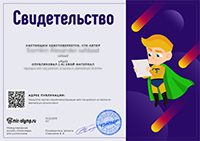| Theme: Our Earth and people in it | School: | ||||||||||||
| Date: | Teacher`s name:Akimchinova M.B | ||||||||||||
| CLASS: 9 | Present: | absent: | |||||||||||
| Learning objectives(s) that this lesson is contributing to | 9.2.2.1. Understand most specific information in unsupported extended talk 9.3.7.1 Use appropriate subject-specific vocabulary and syntax to talk 9.3.3.1. Explain and justify their own point of view on a range of general and curricular topic 9.3.5.1. Interact with peers to negotiate, agree or organize priorities and plans for completing classroom tasks | ||||||||||||
| Lesson objectives | All learners will be able to: - understand important causes of environmental problems and some solutions - extend their understanding of lexis connected to environmental issues - make predictions
| ||||||||||||
| Most learners will be able to: understand detailed information given in a video communicate with each other identify and find solutions for environmental problems | |||||||||||||
| Some learners will be able to: give ideas and express their thoughts argument information to others | |||||||||||||
| Cross curricuiar links
| Geography, Ecology, Art. Nature love and respect to Earth. | ||||||||||||
| Assessment criteria | - Identify the main idea of the video - Use vocabulary words concerning the topic - Answer the questions on the topic - Express opinions - Prove their point of view ( agreeng, disagreeing, negotiating)
| ||||||||||||
| Previous learning
|
| ||||||||||||
| Plan | |||||||||||||
| Planned timings | Planned activities (replace the notes below with your planned activities) | Resources | |||||||||||
|
Start
3min
|
Greeting students Teacher greets students: Hello How are you? Who is on duty today? Who is absent today? Dividing children into groups. Teacher takes 3 pictures of “Land, water and air” and cuts it into pieces. Teacher gives each student a piece. Students should mingle, question each other, put together 3 pictures and build 3 groups. According to pictures children should guess and formulate the theme of the lesson
|
Pictures of Water, land and air.
| |||||||||||
|
30 min |
Presentation of the new lesson.
Teacher offers to watch en episode of documentary film. Children should listen to the video twice and make notes.
Groupwork
a)Pre-listening task: Before listening the audio teacher writes vocabulary related to the topic
Endangered, environment, extinct, habitat, poison, pollution (It helps children brainstorm and activate familiar words)
b) While - listening task: 1. Teacher uses freeze-frame method (stops video) Teacher asks following questions: -In what ways can land be polluted? -What does water pollution include? -How long does it take to break plastic?
Put sentences in chronology according to the video : - Pollution comes on a variety of different ways - Boil of plastic and other subjects takes a long time to be broken naturally -Land pollution can be through many ways including industrial activities, domestic waste and agricultural activites. -Water pollution includes waste waters. ( F. Self-assessment. Teacher shows correct answers on the board and children should correct themselves)
c) Post - listening task: Children should discuss the problems in groups. Questions: -What are the possible solutions for protecting planet? -What do we need to take care of our planet? (Teacher provides opportunities for discussion, encourage them for cooperation and move them to the next question )
2. Each group should draw a picture of a planet, write on the picture of the planet 3 types of pollution and make presentations describing them. They choose 1 speaker for Presentation
FA. Group-assessment.
Descriptors: -activate vocabulary related to the topic -interact with each other - explain their ideas -give facts and arguments -prove arguments
Warm-up: Children should form circle and do what the song tells them to do. Children should dance.
Conclusion
Teacher gives to children worksheets with test –questions: Children should mark sentences a,b,c
a)will happen in the next 50 years b) could happen c) will not happen 1.The climate will get worse 2.The next generation will care more about the environment 3.People will destroy the earth 4. Most cars will be electric 5. People will recycle bags, cans, papers.
( This task helps children to make predictions)
|
Audio
https://www.youtube.com/watch?v=vP3pbh_-pu8&list=PL27786D2ED9C4D357
Active board
Worksheets
Posters
‘The Hokey Pokey’ song https://www.youtube.com/watch?v=S6j7dNraM_k | |||||||||||
|
End 2 min | Reflection: students should tick on their cards when answering the questions
Formative assessment: Teacher analyzes student’s strong and weak points, their current knowledge and gives positive criteria for their participation. |
Papers and markers
| |||||||||||
| Additional information | |||||||||||||
| Differentiation – how do you plan to give more support? How do you plan to challenge the more able learners? | Assessment – how are you planning to check students’ learning? | Cross-curricular links | |||||||||||
| Differentiation by support: Each group should chose 1 speaker, who helps to less able children and presentate their work
| FA Teacher’s oral comments: In Pre-listening task teacher gives positive comments
FA Self-assessment: In while-listening task children assess themselves with support of a teacher
FA Group-assessment : In post-listening task groups assess each other by criteria
| Technology Respecting professions | |||||||||||


 666
666 13
13


 Our earth and people in it
Our earth and people in it 